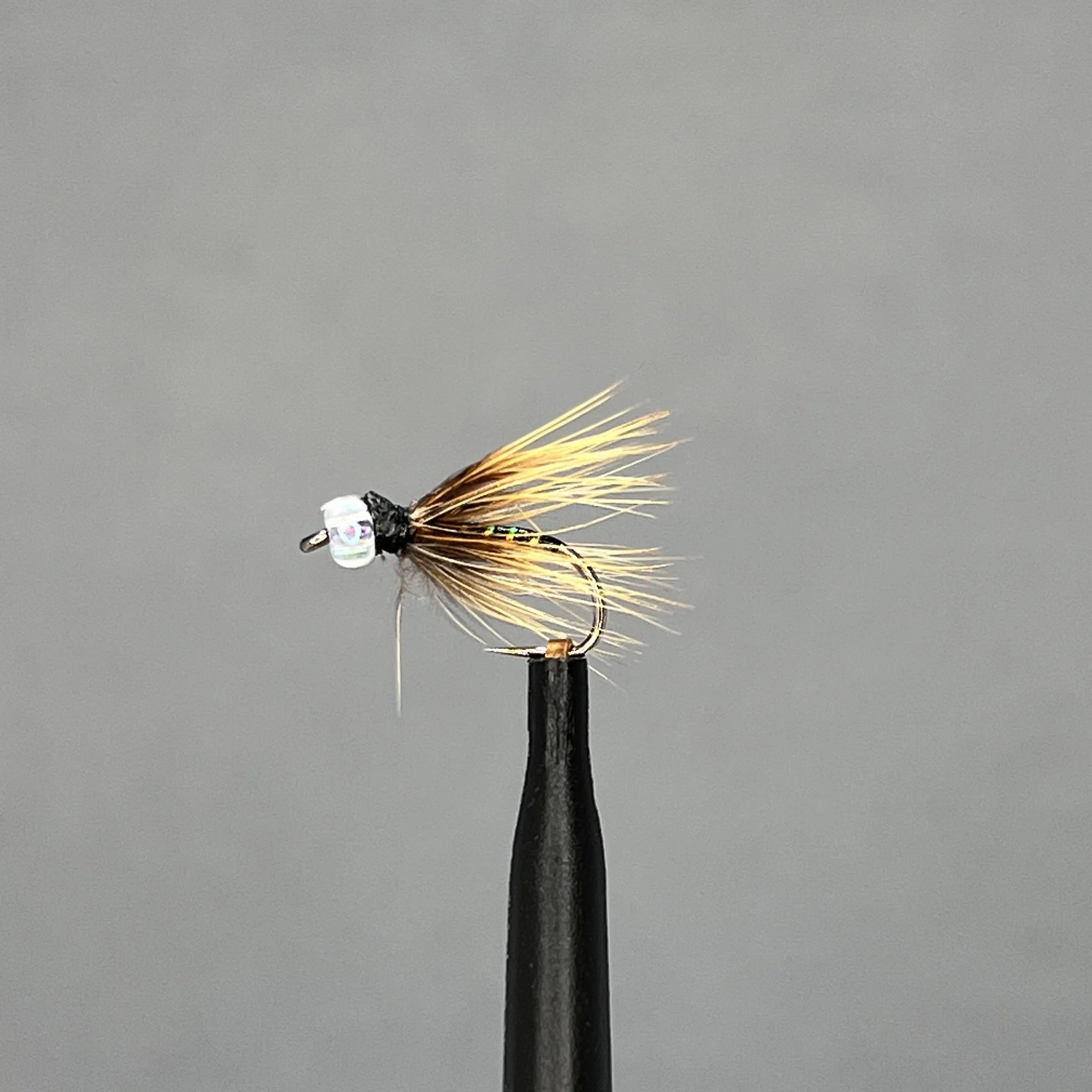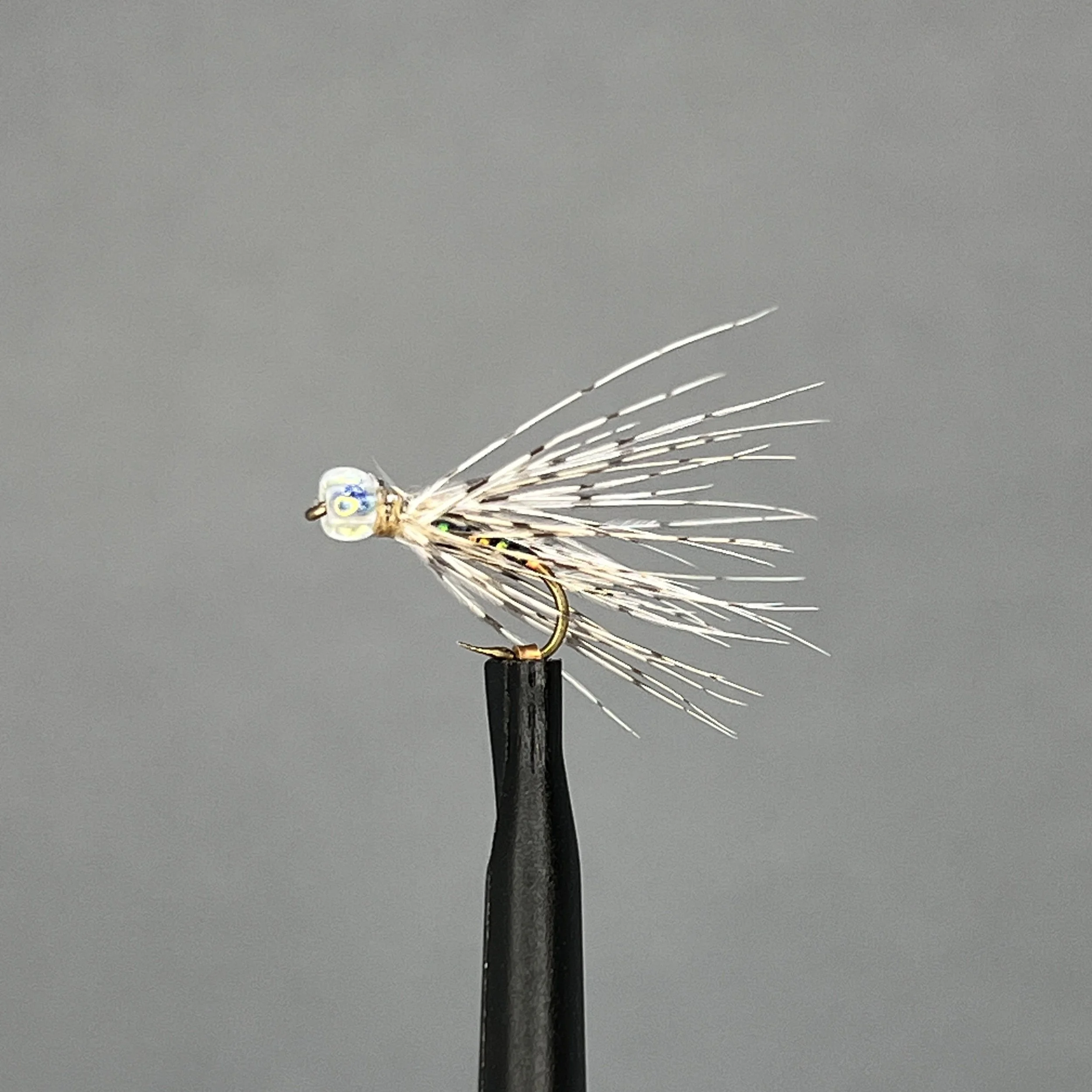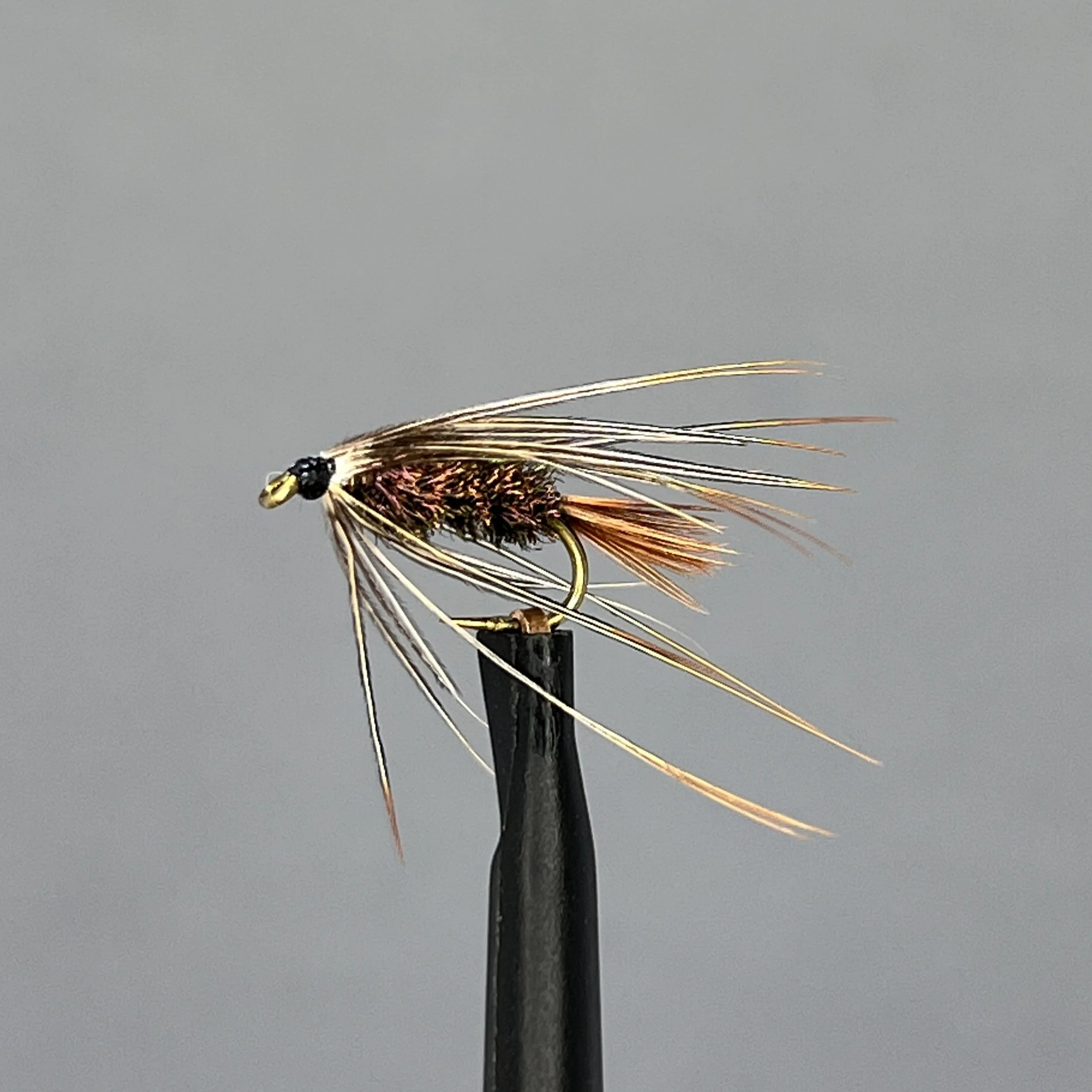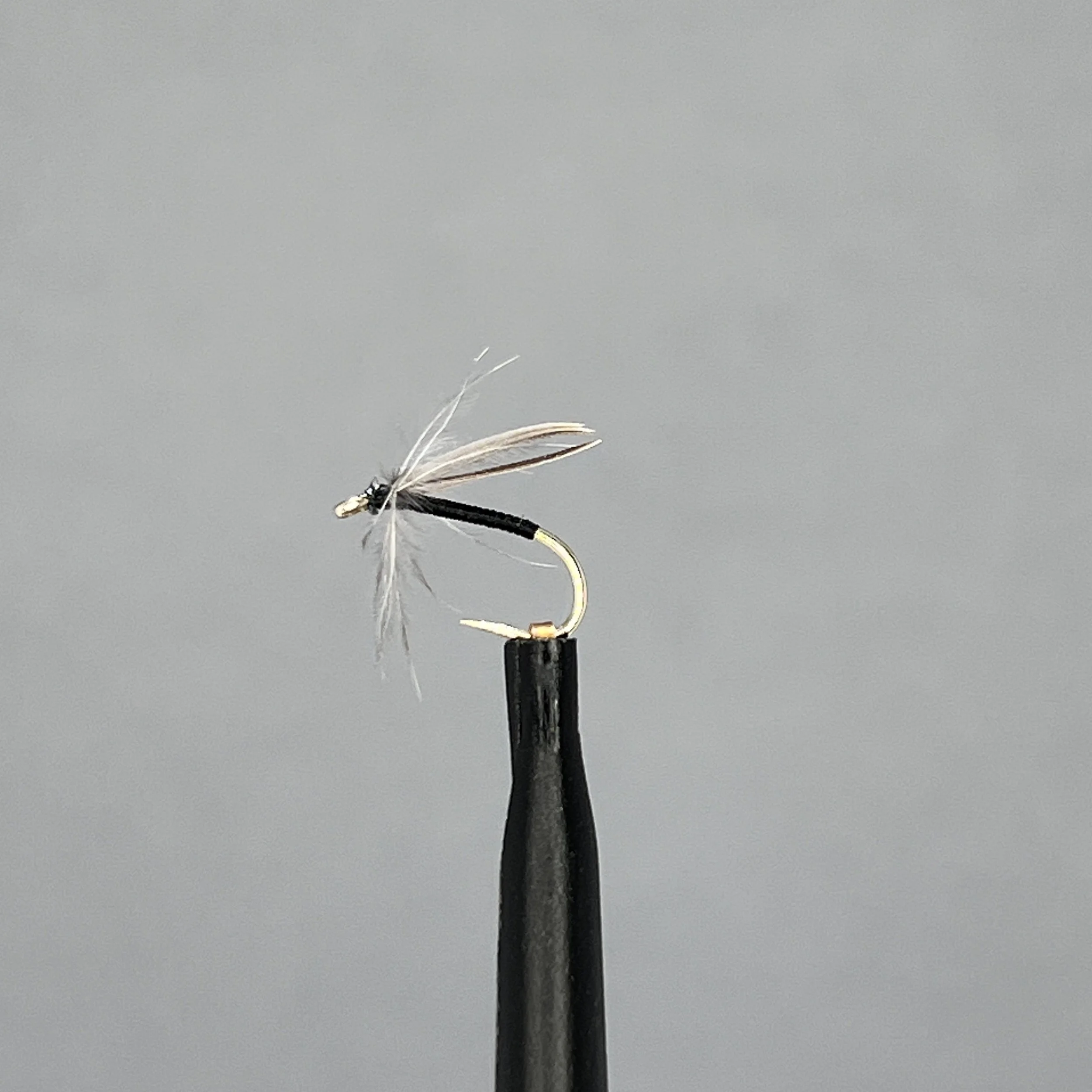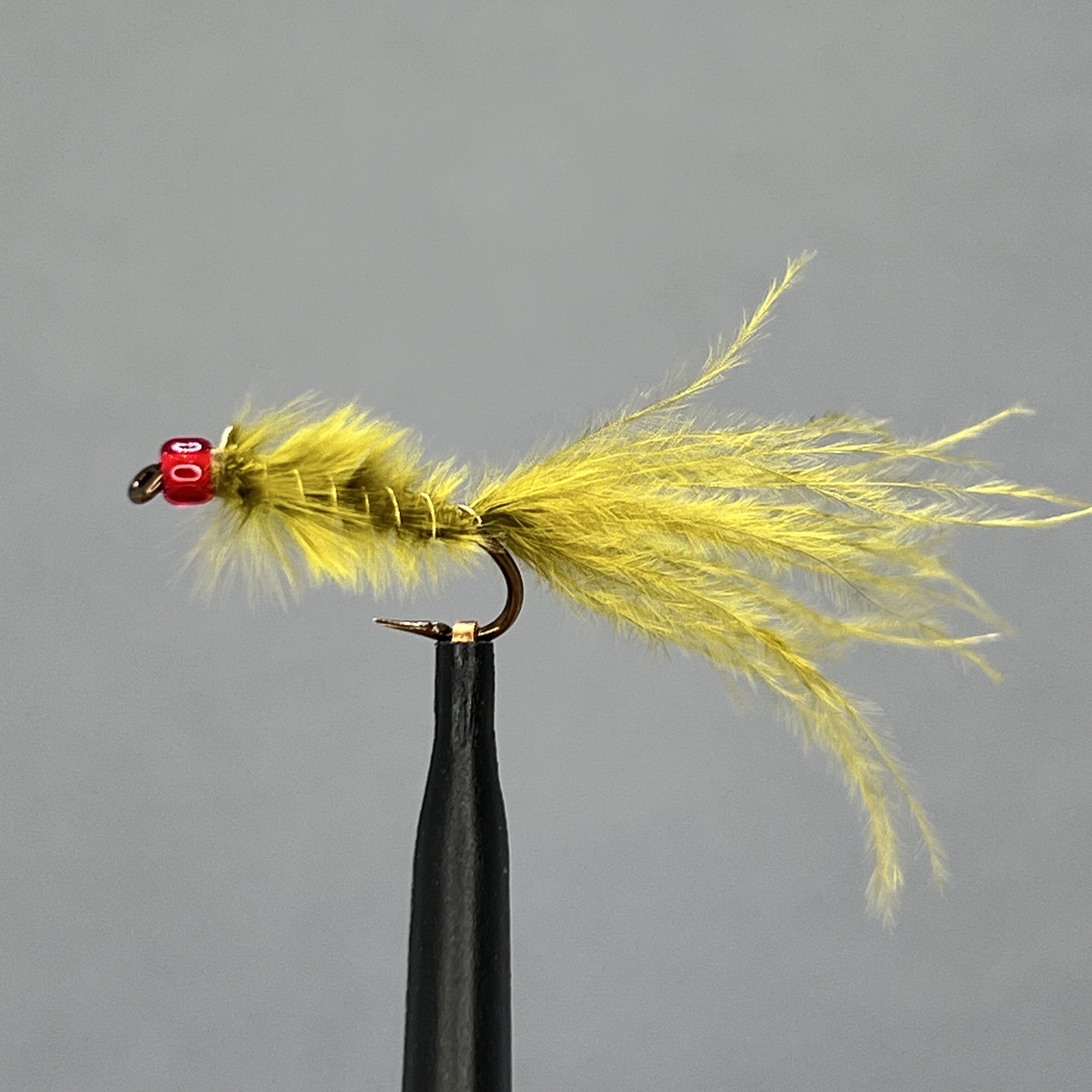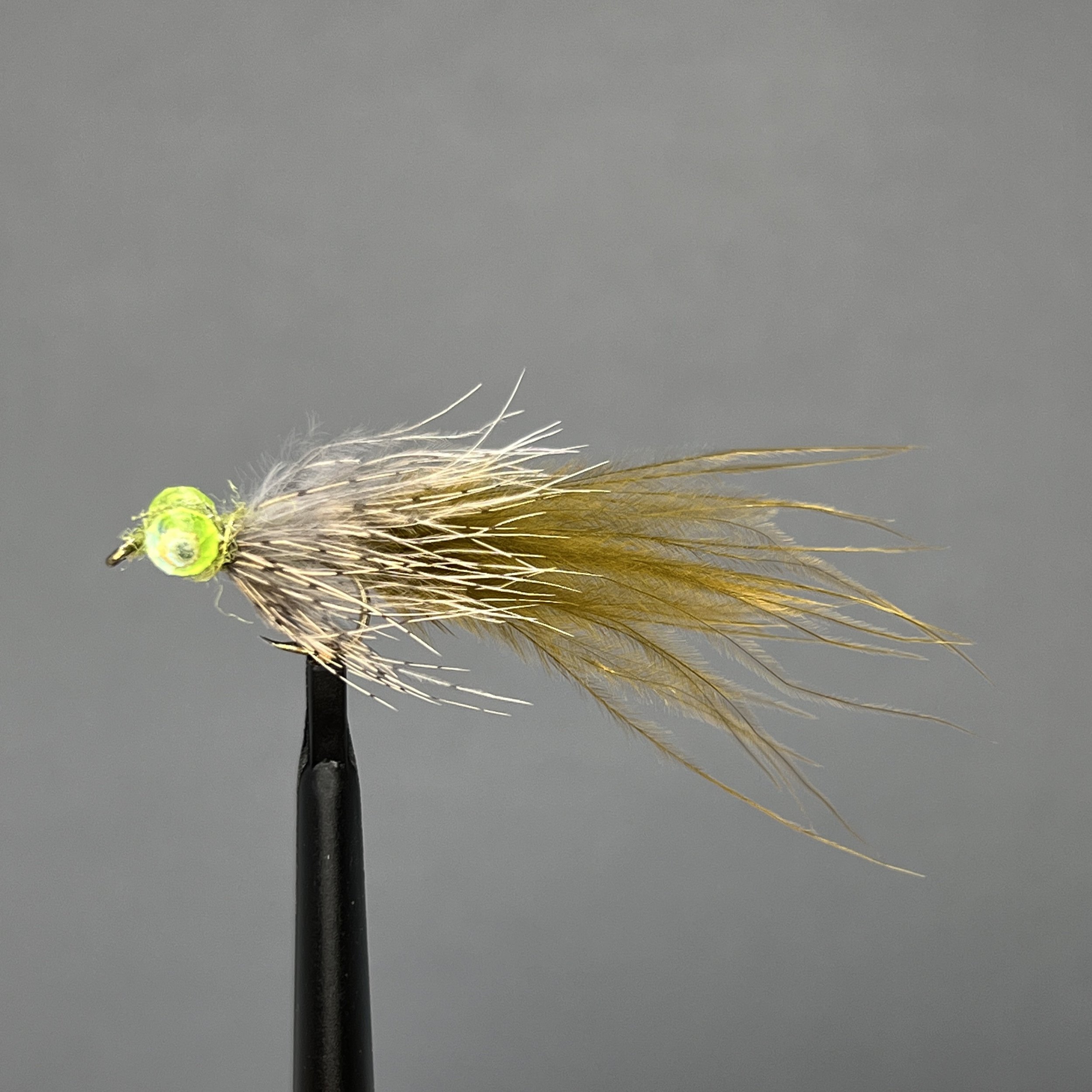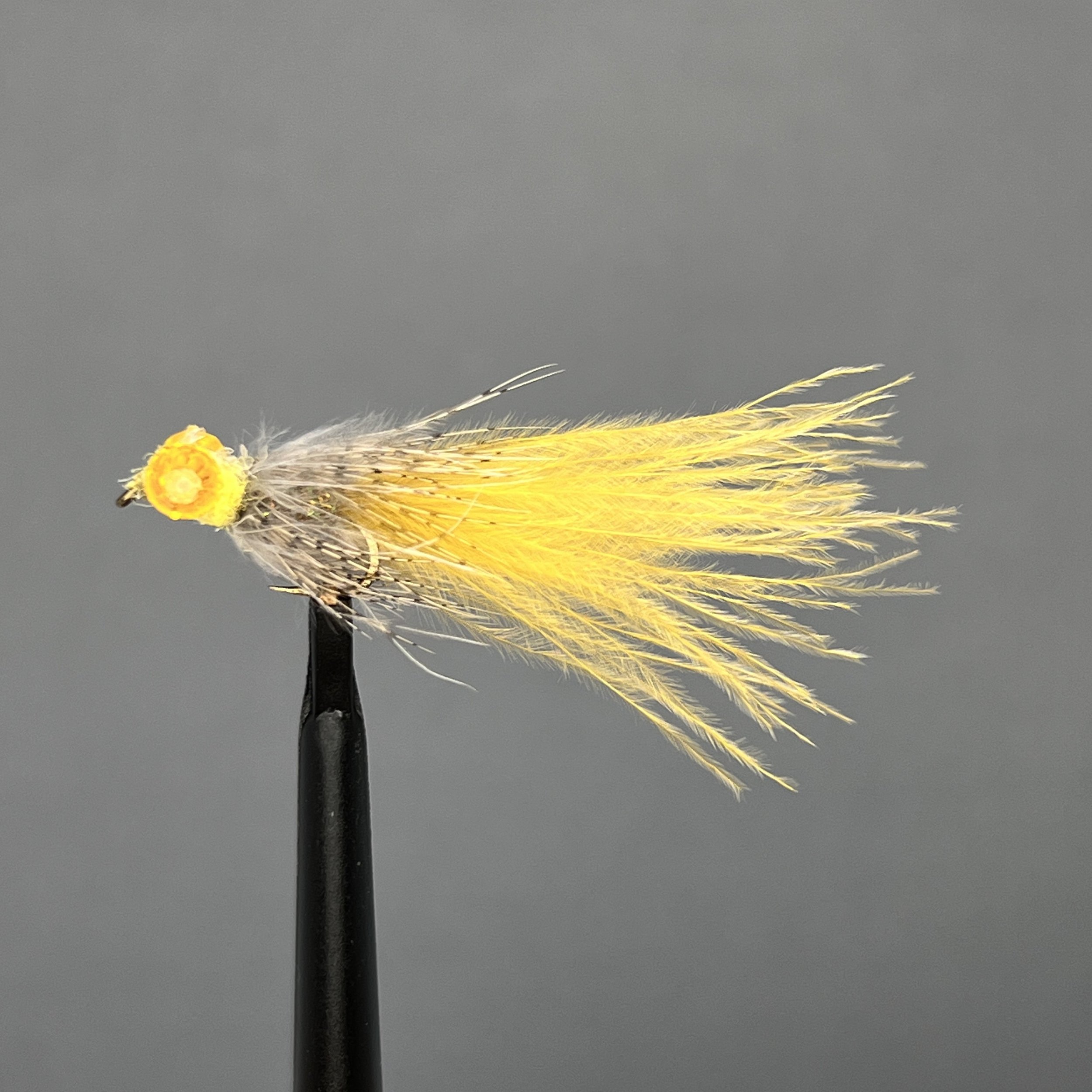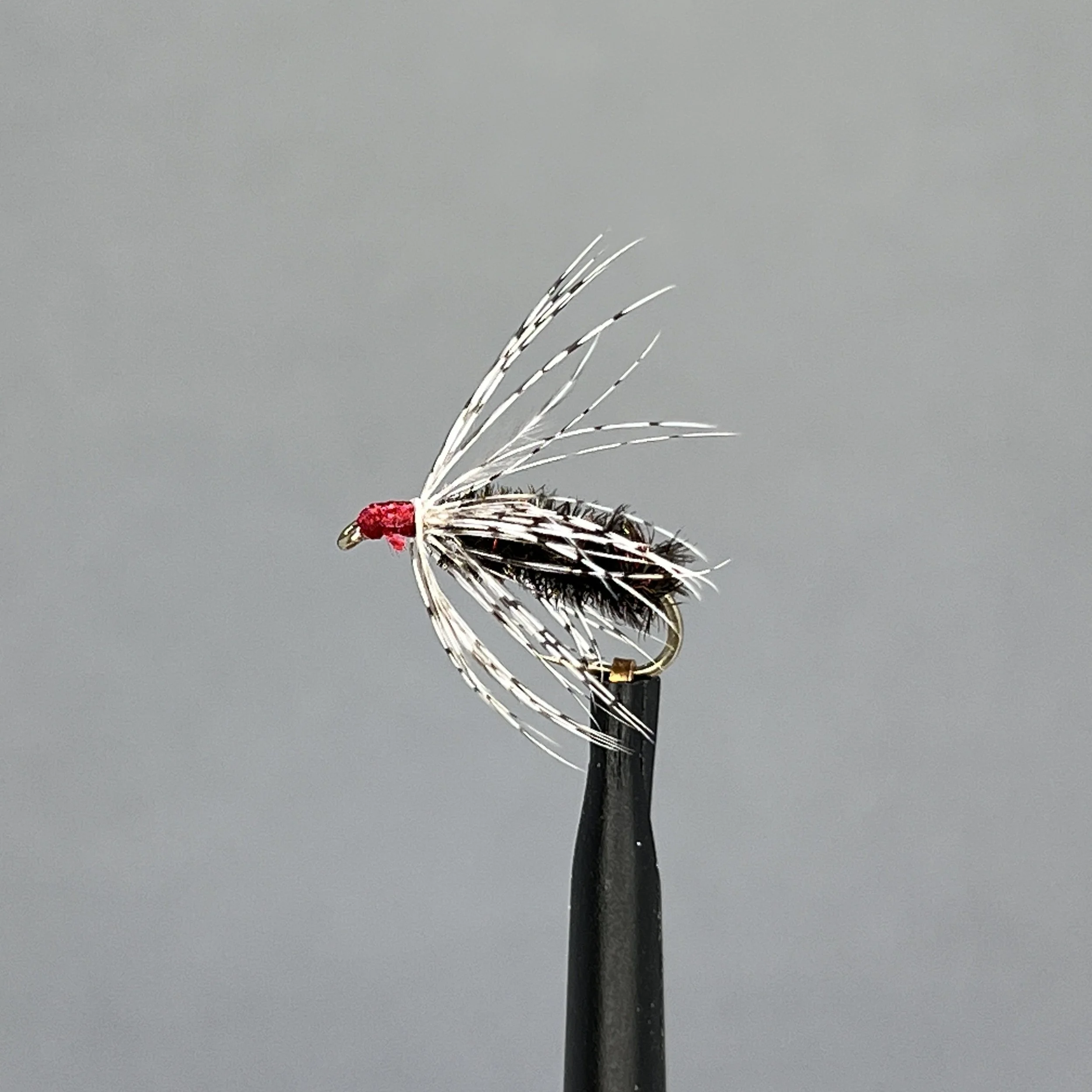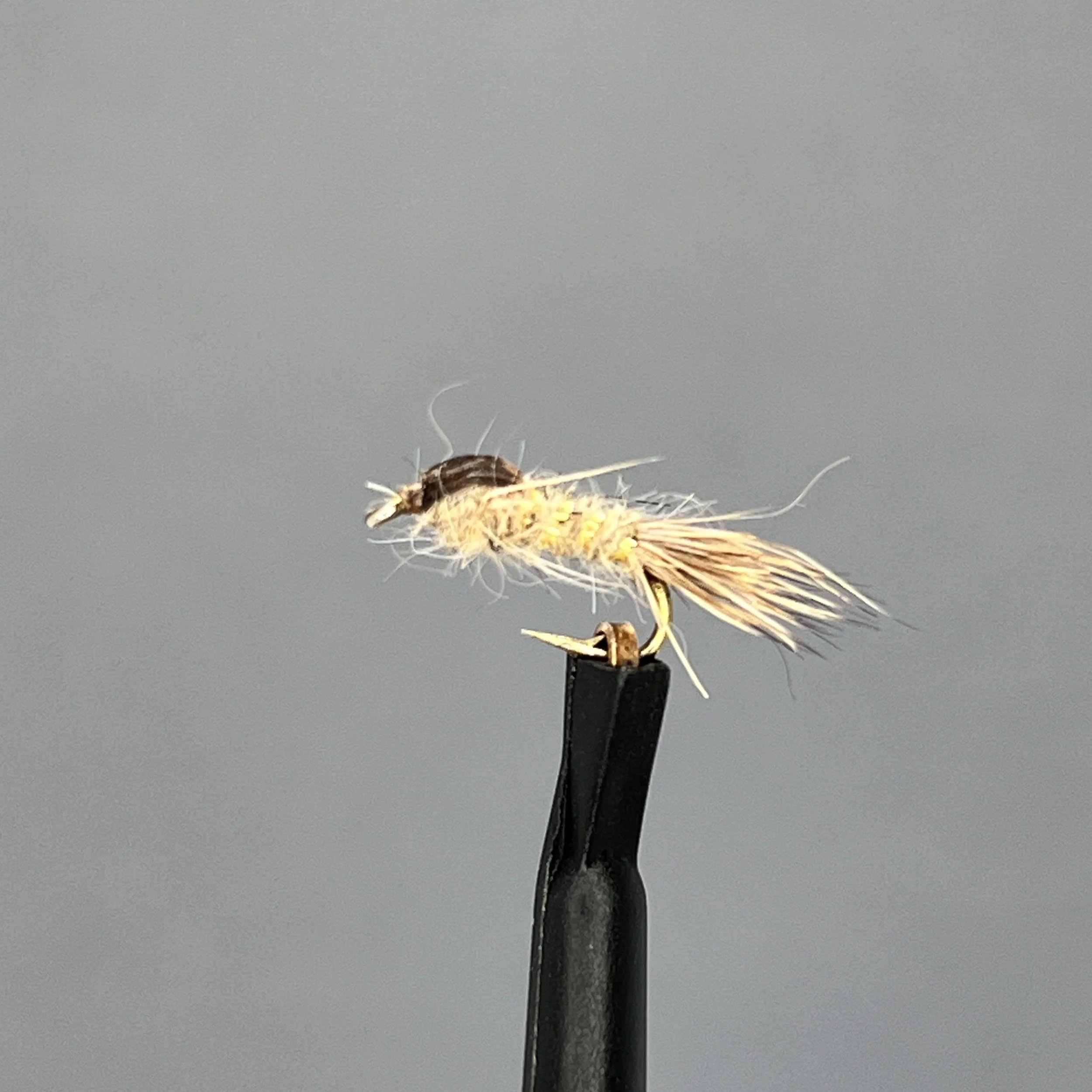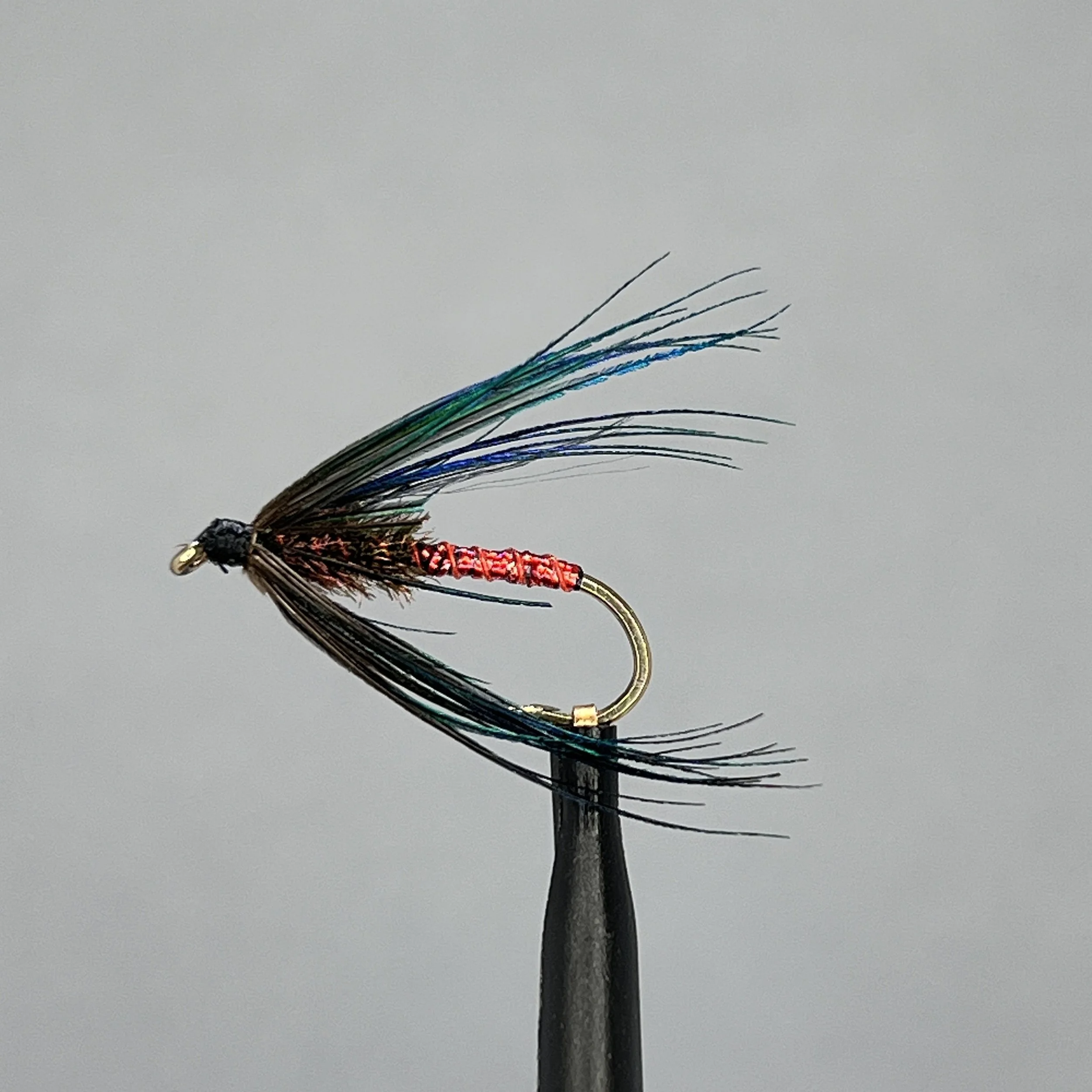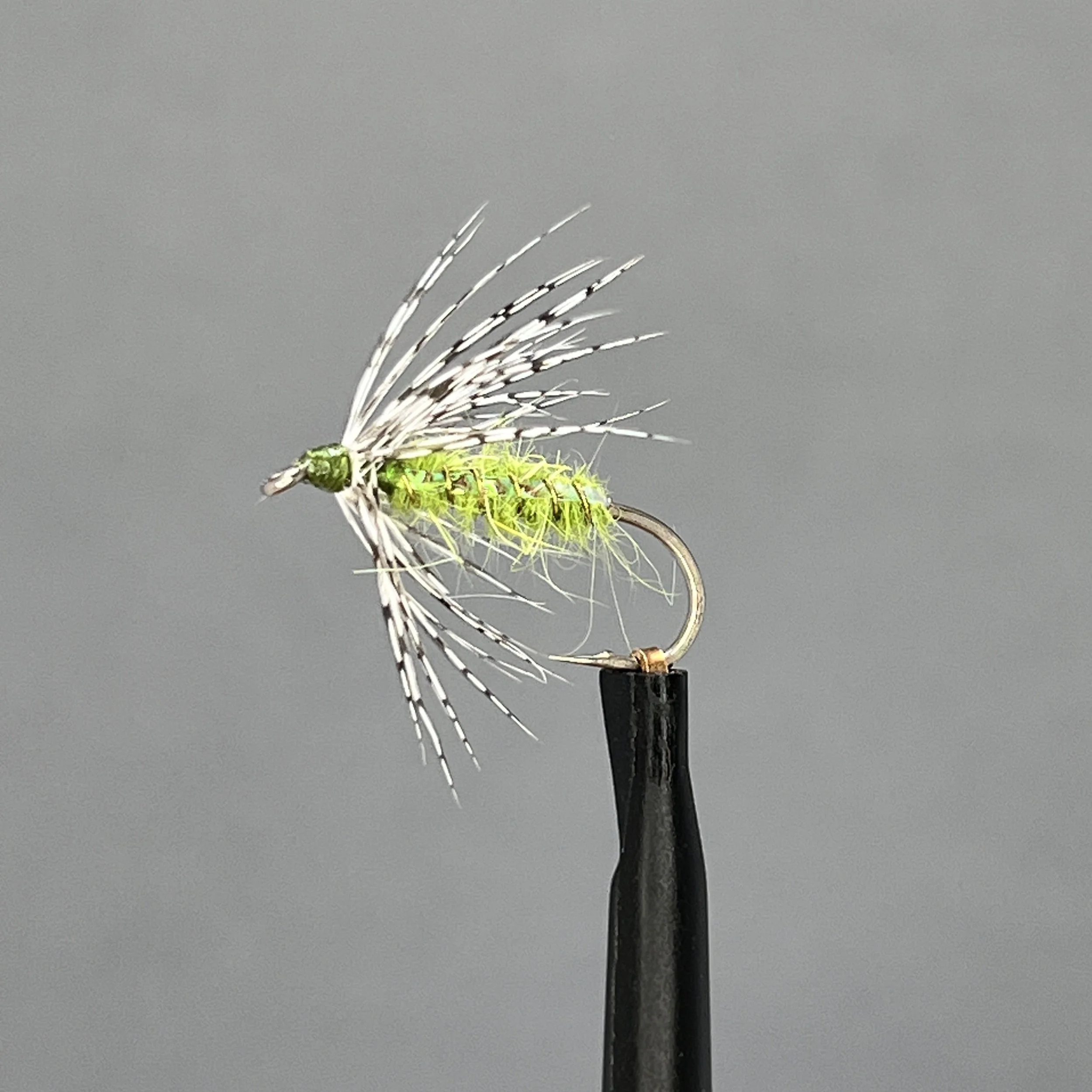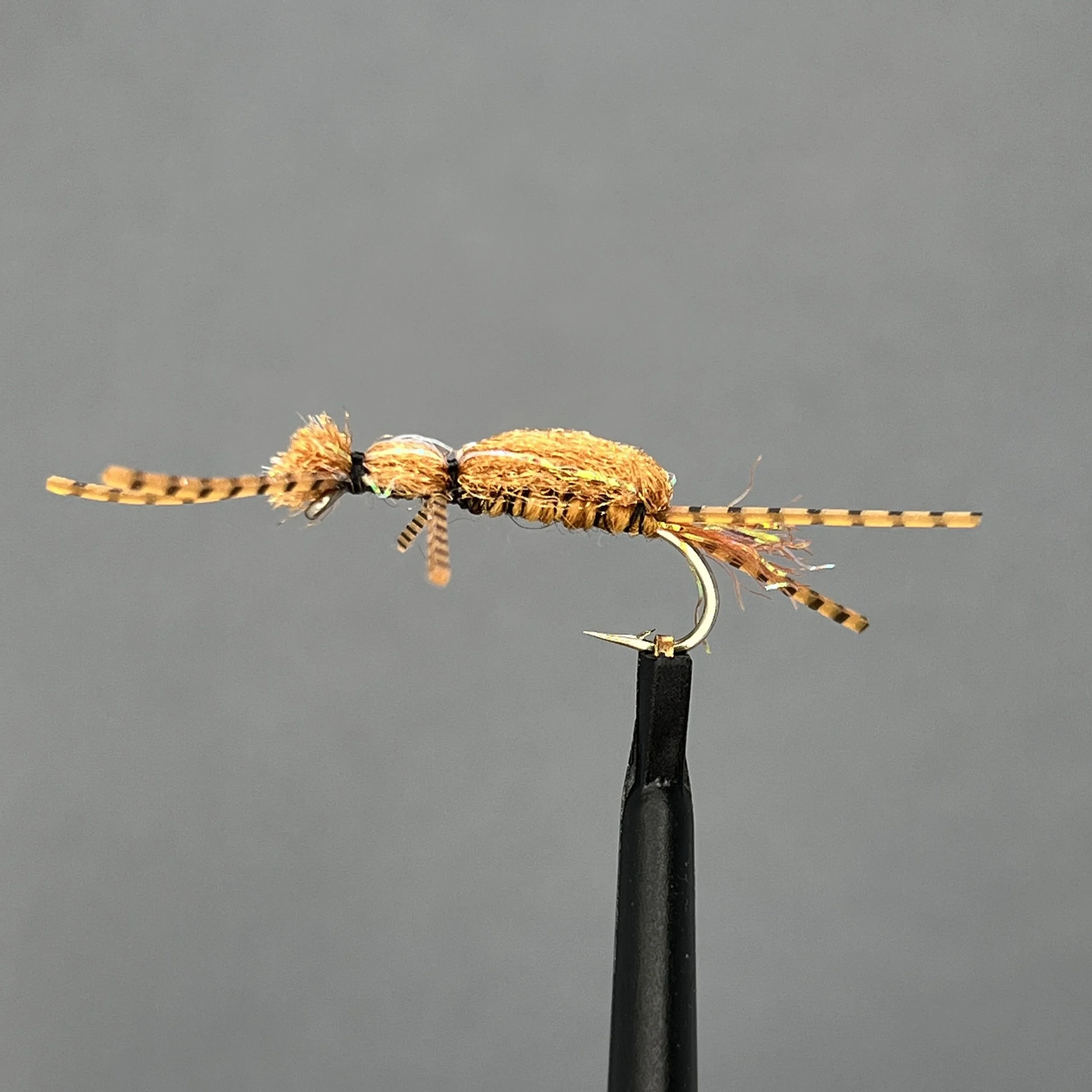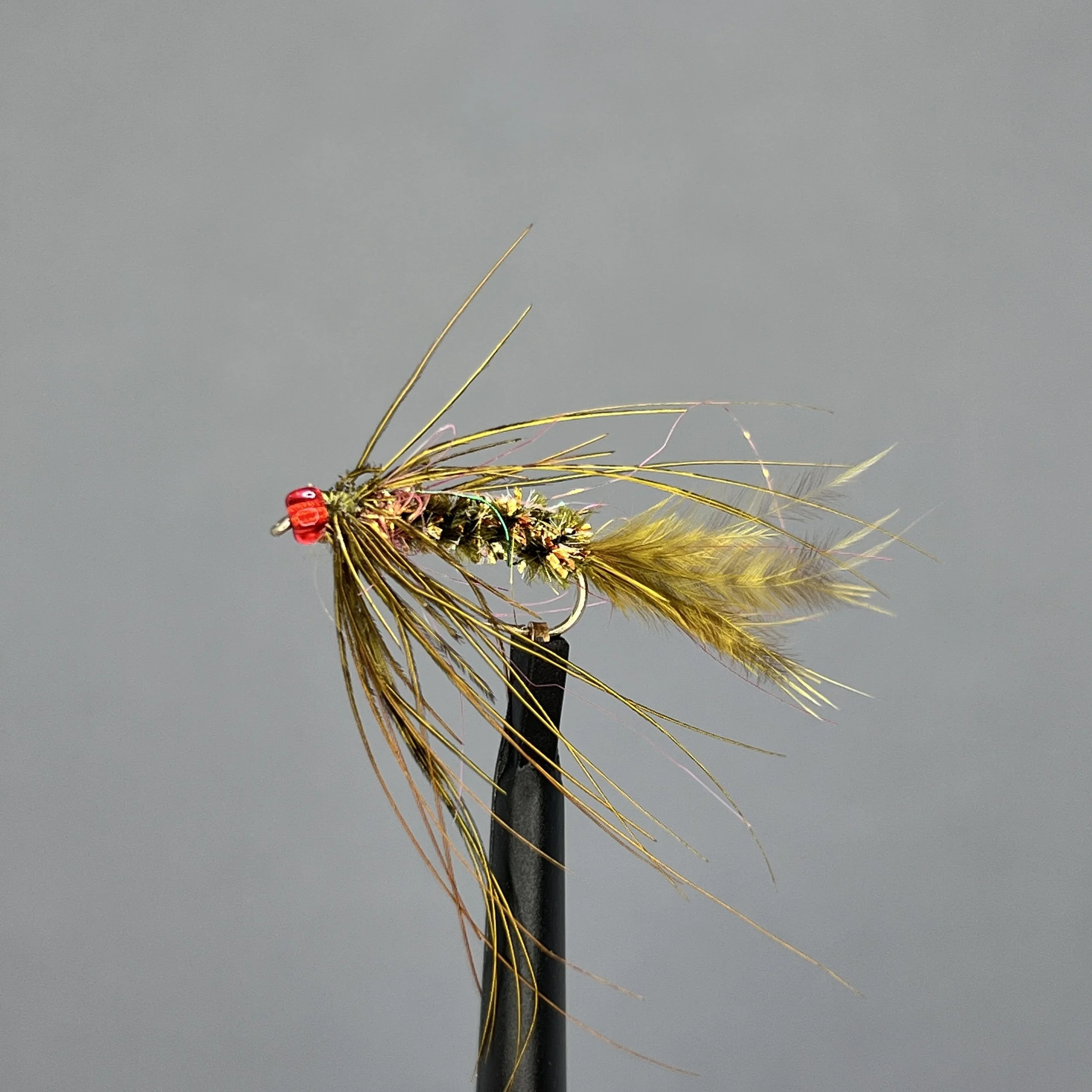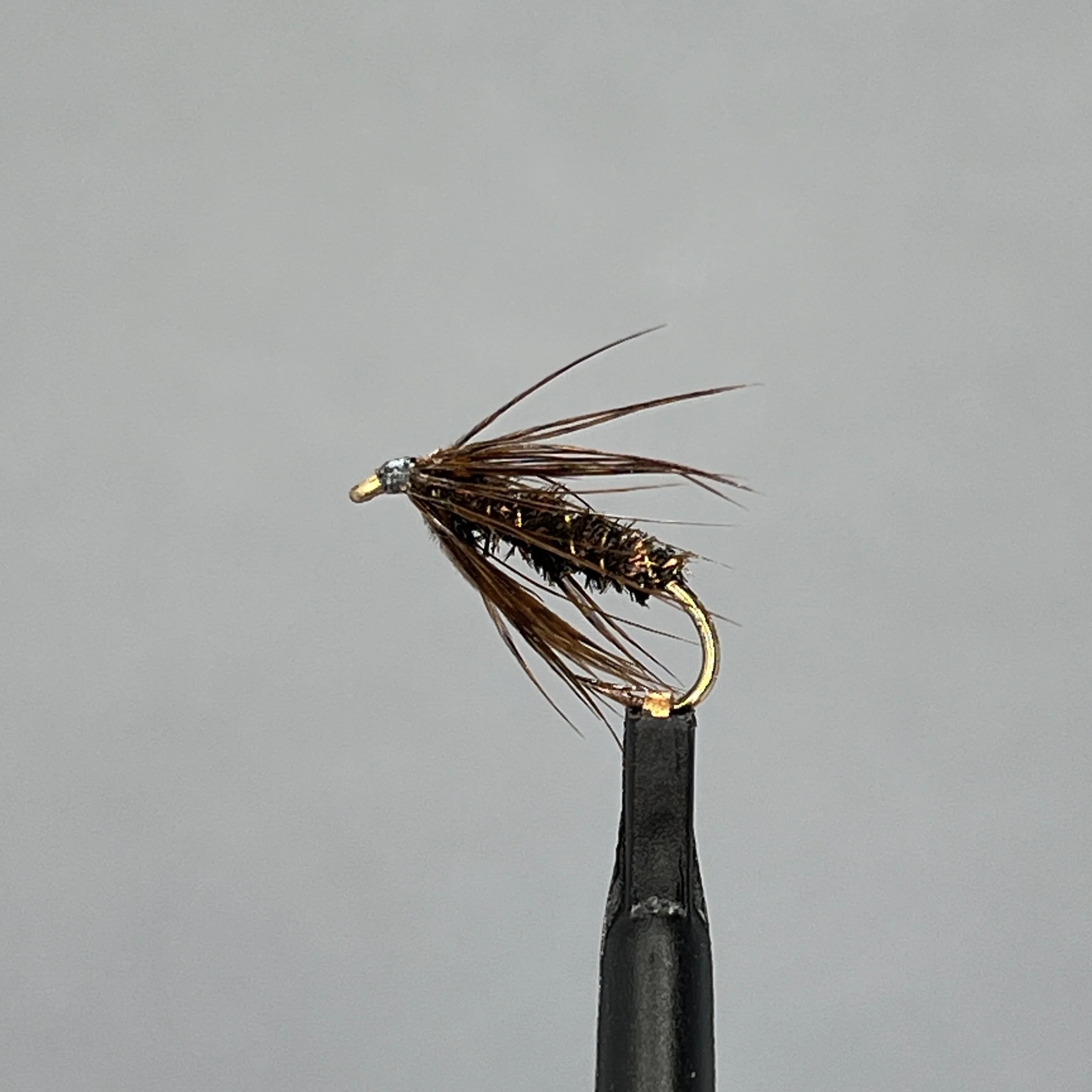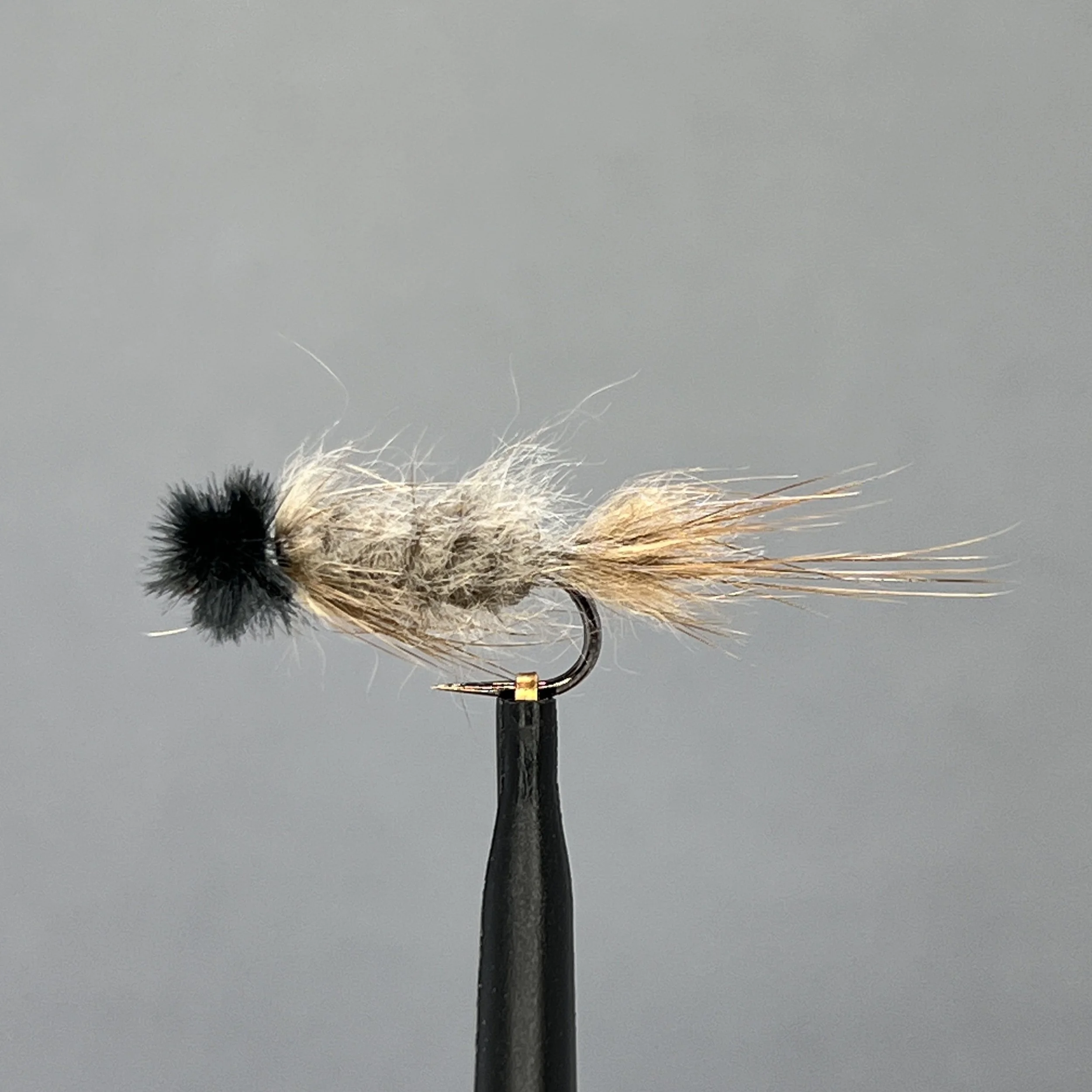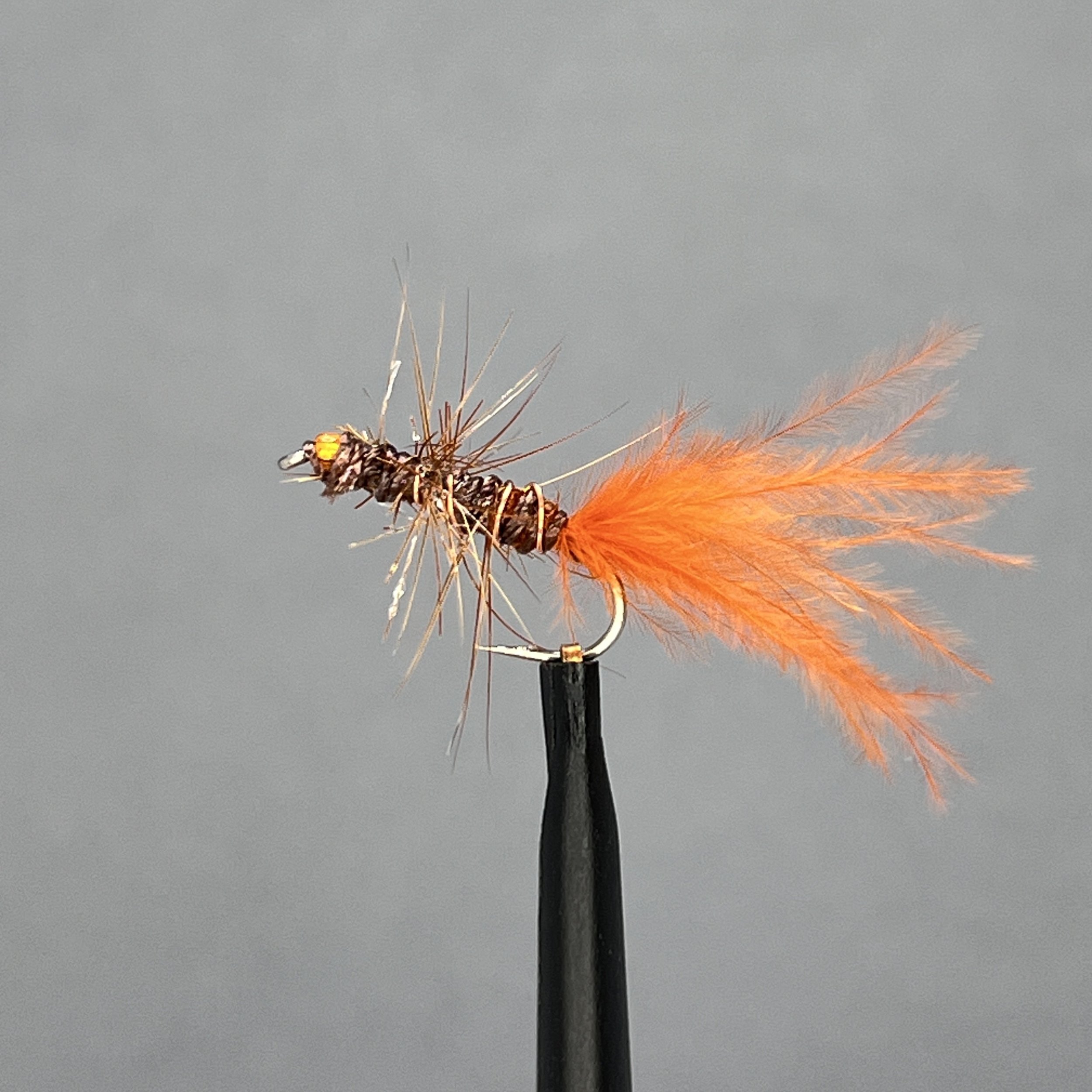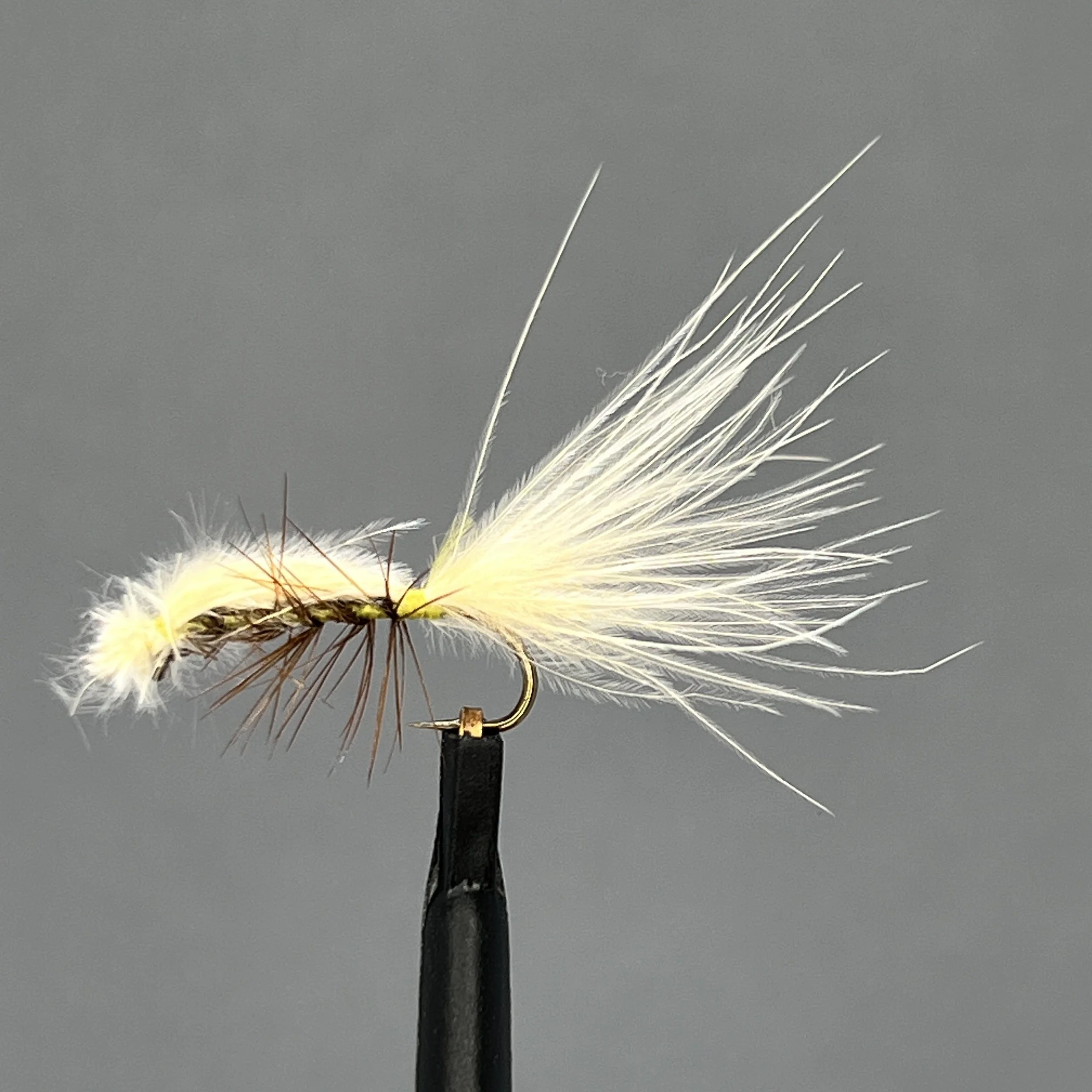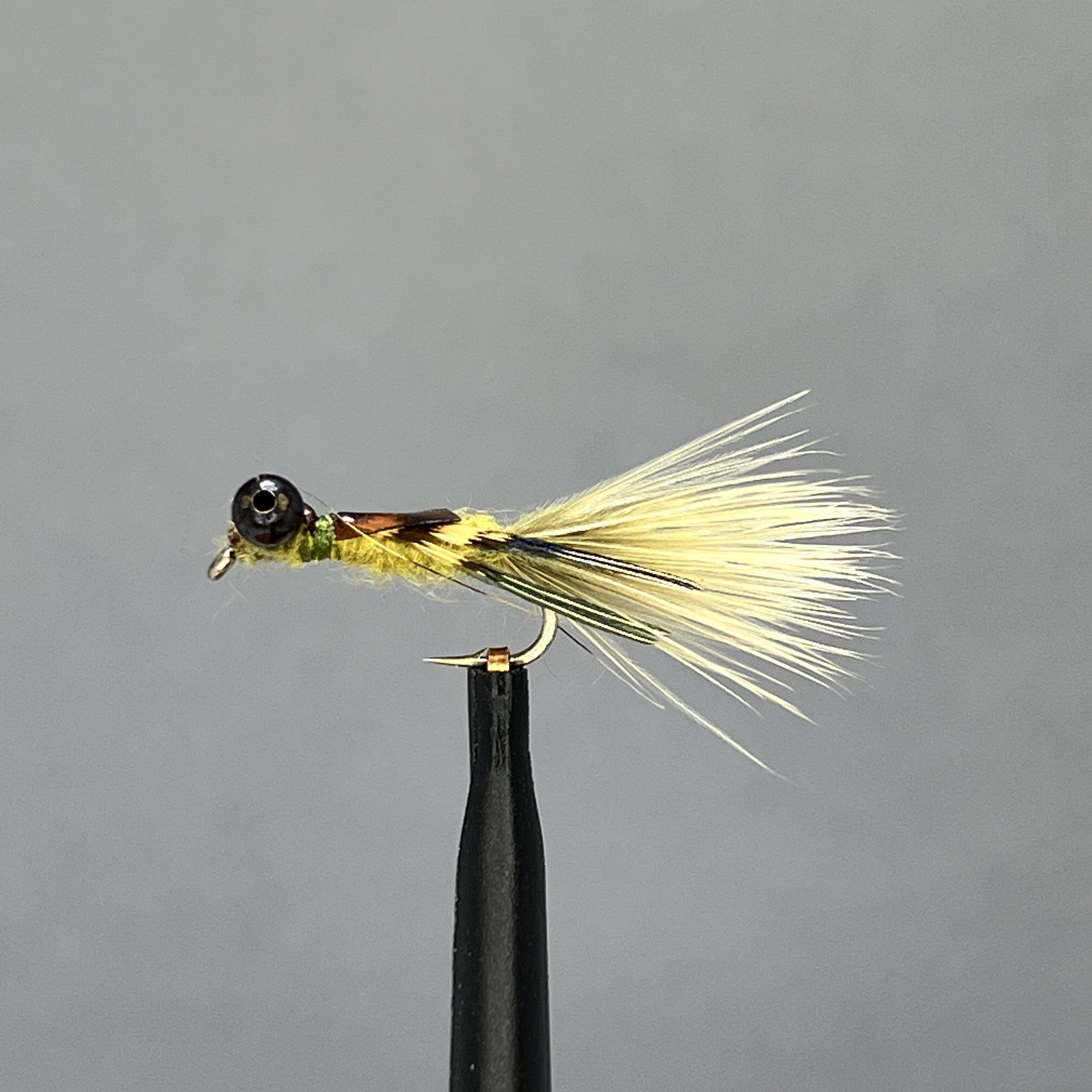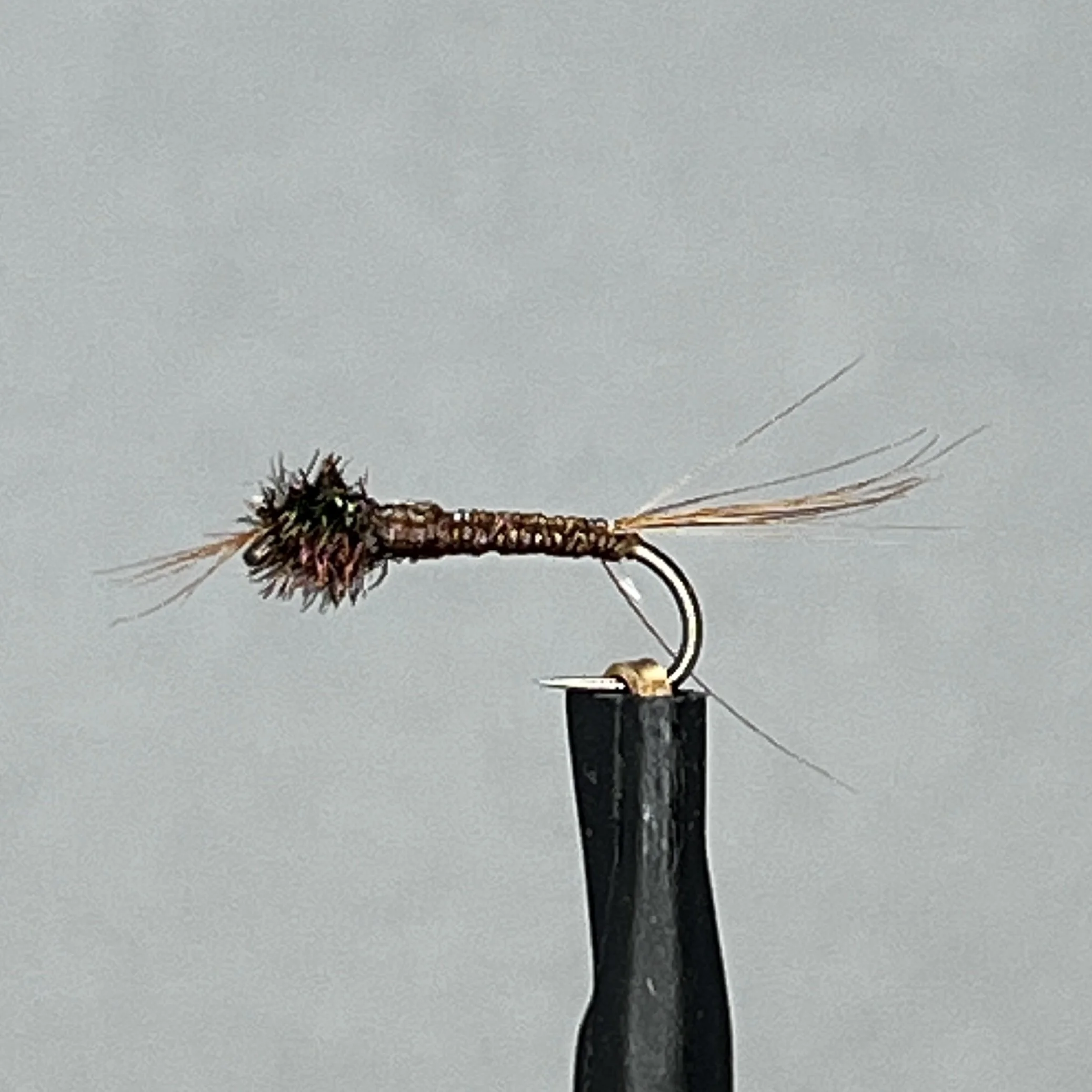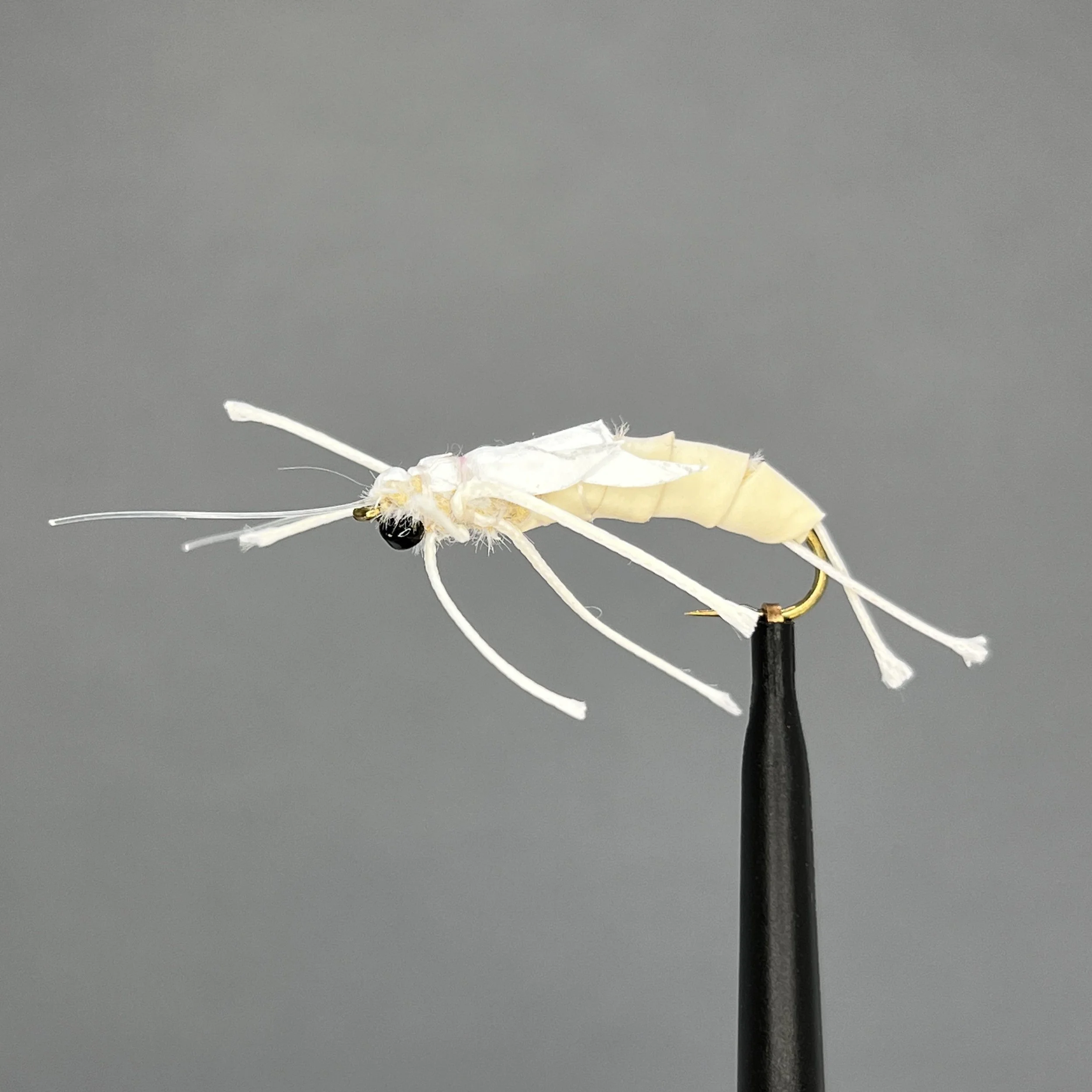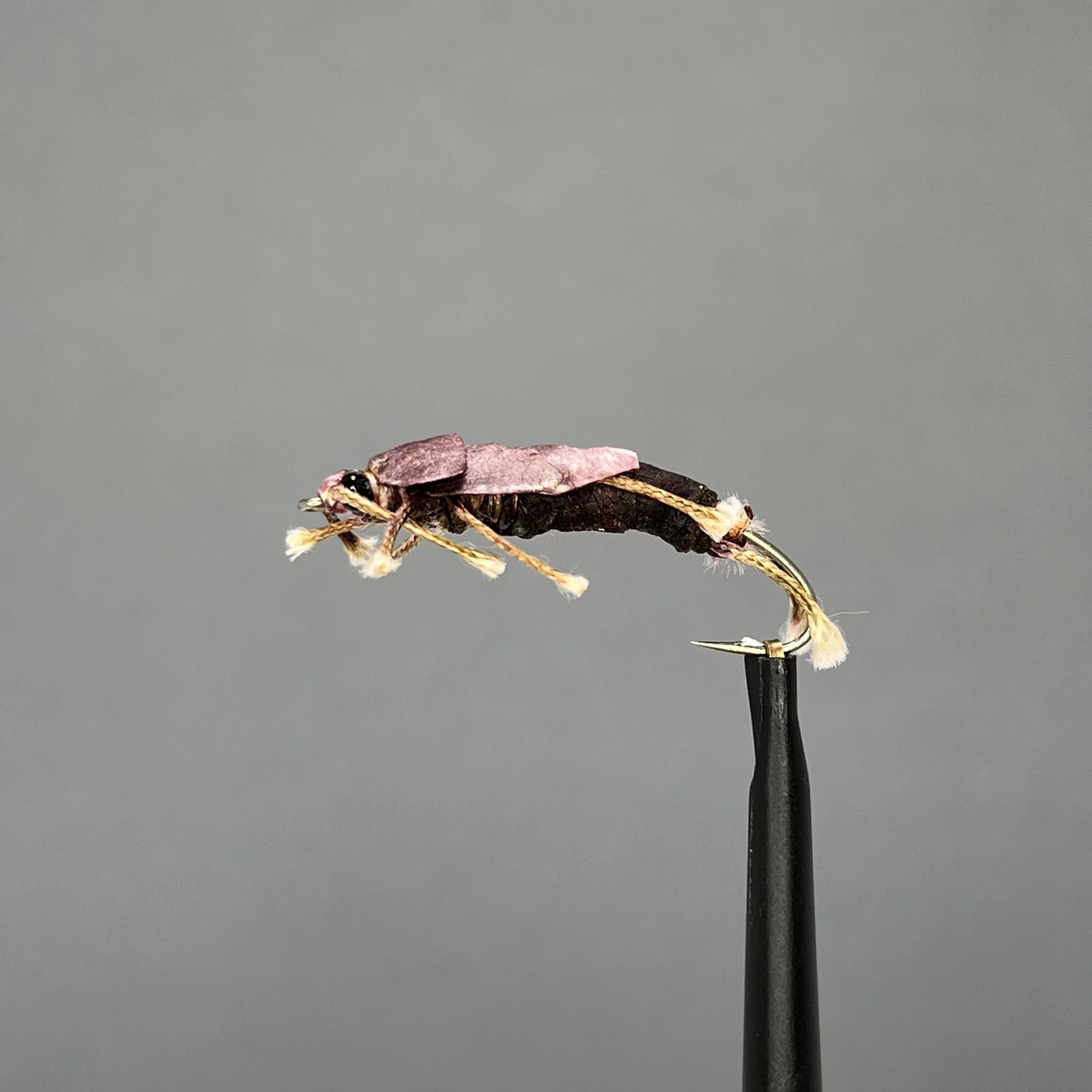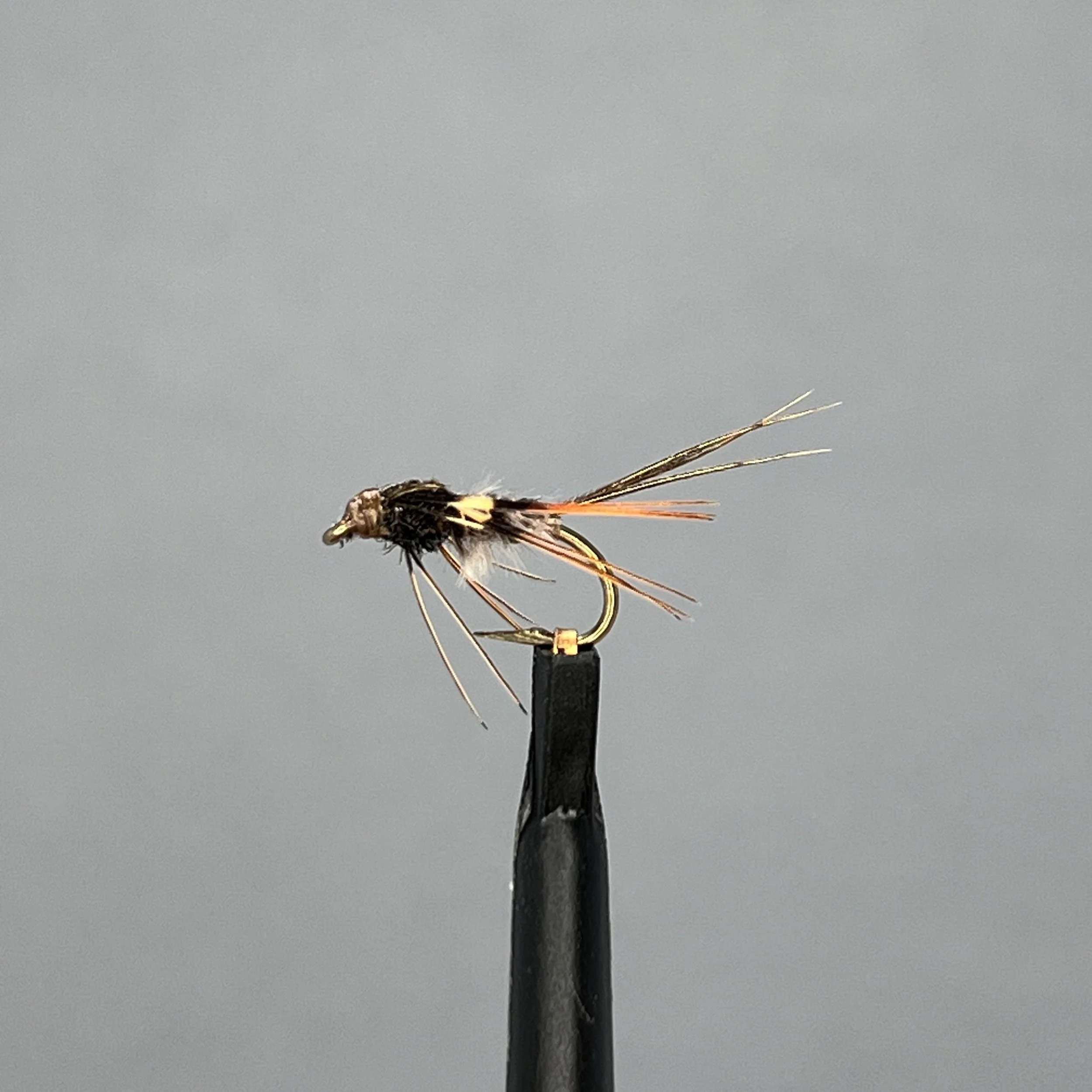FAVORITE PATTERNS OF CLARK-SKAMANIA FLYFISHERS
Wet Flies and Nymphs
Beadhead Softhackle
Paul Smith
#14 or 16 wet fly
Hook:
Uni 6/0 or 8/O, black
Thread:
Black thread with overwrap of purple or hot orange [UV] Crystal Flash
Body:
Ruffed Grouse
Hackle:
Small clear plastic bead
Head:
1. Debarb hook and slide bead to the eye of the hook.
2. Start a thread wrap behind the bead and a small build-up of thread to secure the bead in place. Continue wrapping thread back to just before the bend in the hook.
3. Secure the tip of 1 piece of Crystal Flash where you ended the thread and wrap 6-8 wraps with space between wraps up to the bead. Secure Crystal Flash with 3-4 turns of thread. Cut excess.
4. Cover the thread/Crystal Flash with a layer or two of Sally Hansen Hard-As-Nails or favorite glue) and let dry.
5. Tie in the hackle feather, tip first, just behind the bead and make 2-4 turns.
6. Whip finish/secure the hackle and trim the excess feather and thread.
7. Dab a small amount of Hard-As-Nails over the hackle thread.
Note: I like to use Hard-As-Nails instead of super glue for the body cover because it dries clear and it will increase contrast of the black thread with the Crystal Flash wraps much more than if not used.
Timothy Buckley
Carey Special
# 4-14 heavy wire, long shank (nymph or streamer)
Hook:
Black, olive, or brown
Thread:
Pheasant tail (Timothy’s variations substitute natural pheasant rump feathers, even partridge...even no tail at all) . Records show early patterns often used bear hair.
Tail:
(soooo many options to try): “Ice Dub Holo Olive”- or- Hairline Peacock dubbin, Peacock Herl (per original…see photo) , mohair, bamboo metallic thread, or chenille.
Body:
Copper wire
Rib:
Long soft-hackle - Pheasant tail (Buckley’s Variations substitute natural pheasant rump feathers, or even partridge, these are perhaps not as durable as pheasant tail, but gives more motion in the water).
Hackle:
Whip finish and cement
Head:
Tying Instructions:
1: Pinch hook barb. Start thread at eye and wrap back to bend.
2: Short tail: Using some feather barbs to match the hackle, tie in a short tail [if tail to be included], length somewhere between 1/3 of the hook shank, down as short as the gape distance or less.
3: Tie in copper wire for rib.
4: Tie in Peacock (or other body material). Use dubbing loop or preferred method and wrap forward (I prefer a thin body). Wrap towards eye but leave enough space for hackle and head.
5: Counter wrap wire rib and tie off.
6: Tie in Pheasant rump feather behind the eye. Select feather with individual barb fibers slightly longer than the body.
7: Wrap several turns of soft hackle as a collar and tie off. I prefer a thin collar to emulate legs and show movement with out obscuring the body.
8: Whip finish and apply head cement.
Notes: Traditionally a still-water fly assumed to imitate a damsel or dragon fly nymph, even caddis nymphs, mayfly nymphs, and leeches …or heck perhaps it’s just an attractor, also used now in moving water for trout and steelhead. A great pattern for an alpine lakes searching pattern either trailed as a dropper behind a dark leech or woolly bugger pattern, -or - if weighted or on a sinking line as the primary with a flashback PT or Scud dropper. I tie a variation of this in sizes 16-18 with silk floss as a fast-water soft hackle to represent drifting mayfly nymphs.
Traditionally assumed to have been invented by Colonel Carey in 1925. The grandfather pattern is thought by some to be the “Monkey-Faced Louise” developed about 1925 by a Dr. Lloyd A. Day of Quesnel, British Columbia [named after his wife?] …according to Sheldon Seale in a 2003 article in Canadian Fly Fisher, and in Fish-Flies by Terry Hellekson.
Author Steve Raymond, in his book Kamloops, indicates that Col. Tom Carey may have instead designed the pattern after an earlier pattern known as the Knouff Special. Whatever the true history of its predecessor patterns, Colonel Thomas Carey has been given the credit when he popularized the pattern in 1925 and the fly was eventually renamed in his honor.
Stillwater: As a searching pattern trolling on a sinking line or use the count-down-and-retrieve or slow retrieve presentations. I have had great success with casting out and letting it sink, then retrieve with a series of (3 or 4) 4-6” quick strips, then pause for a few seconds, repeat (then land fish, take photos, release, then repeat). Even used on moving water… fish as a streamer.
Additional notes from Timothy:
I often tie some with out a tail: I had been finding I would often get multiple bumps or taps without hookups, I decided to clip the tails short, or rip completely off assuming the fish were following the fly and only grabbing at the tail. With the new very stubby tails – or no tails, I had no more “bumps…they all became hookups instead. (I thought my personal variations on the pattern found in Westfly were unique, in researching the fly history however I found my experimental variations with soft-hackle and omitting the tails were nearly a reversion back to the original pattern itself).
Joe Smith
Carey Special
Tiemco 3761 2X Sproat Bend Nymph
Hook:
Veevus 70 Black
Thread:
Pheasant Brown Fibers 1/3 body Length
Tail:
Peacock Herl
Body:
Pheasant Rump
Hackel:
Fine Copper Wire
Rib:
Small Black
Head:
Notes: A very simple tie. Great for a subsurface search pattern.
Peter Anderson
Clyde-style Midge
Any wet fly, size 14 - 18
Hook:
Black, or dark gray 70 dineir
Thread:
Body:
Two wraps of thread
Small piece of Starling wing
Wing:
1-2 turns of small Starling breast feather stripped of fibers on one side
Hackle:
Notes: Keep it sparse. This works really well as a dropper on a dry fly on lakes or swung behind a wet fly in a river.
Doug Anderson
Damsel Nymph
#10-16 nymph hook; standard or 2X length
Hook:
size 6 (for larger flies) or 8 (works best on the smaller versions) Color to match fly
Thread:
Marabou to match body equal to hook length
Tail:
Marabou twisted into a rope. Olive seems to work best.
Body:
Gold or copper wire
Rib:
Red bead seems to be the best
Head:
This fly is similar to one I was introduced to by Denny Way at Lenice Lake and tied by many CSF tiers. Chuck Holstein provided me with many for Goose Lake and other still waters. This variation has worked fabulously in the lakes on the White Mountain Apache Indian Reservation and national forest lakes near Pinetop, AZ. It can be fished as a stand-alone nymph or under a dry fly indicator. It also works well when fished behind a streamer like a Wooly Bugger. It has brought in several Apache Trout (unique to AZ) as well as lots of rainbows and cutthroats as well as a few brown trout.
Damsel Nymph
Paul Smith
#10 or 12 wet fly
Hook:
Uni 6/0 or 8/0, tan or olive
Thread:
Olive/Pearl Sparkle Braid [for green damsel] , Tan/Pearl Sparkle Braid [for tan damsel] Olive/Pearl Sparkle Braid [for green damsel] , Tan/Pearl Sparkle Braid [for tan damsel]
Body:
Gold, olive or light green marabou
Tail:
Ruffed Grouse
Hackel:
Green Medium Olive Squirrel Brite [for green damsel] , Sulphur Squirrel Brite [for tan damsel]
Head:
Beads and 20 or 301b. monofilament
Eyes:
Notes:
1. Dumbell eyes: First cut a small, maybe 2" piece of 20 or 301b. monofilament and place a bead onto it with about 1/8" of mono sticking out of the end of the bead. Take a lighter and melt the 1/8" mono. Allow to melt up to the bead then wet your thumb and press against the bead. Run the second bead down to the first. Now with a narrow-tipped set of forceps, place between the beads and cut the excess mono down to 1/8" sticking out from the second bead. Repeat the of the mono and let melt down to the second bead. Wet thumb and press.
2. Debarb hook [if not barbless] and place in vice.
3. Start thread a few millimeters down from the eye of the hook. Attach the dumbbell eyes with alternating/counter wraps around the bead eyes with a few in front and back of the eyes to secure the eyes in place. Place some superglue around the thread wraps around the eyes to secure in place.
4. Continue wrapping thread back to the bend of the hook.
5. Tie in a small bunch of marabou for a tail.
6. At the base of the marabou tie in a 2" piece of Sparkle Braid and continue the thread forward.
7. Lay down a base of super glue on the thread and wrap the Sparkle Braid forward to the eyes leaving a little space for the hackle and head wrap.
8. Tie in the hackle, tip first, and wrap 2-3 turns. Secure the hackle with a few thread wraps and cut off excess hackle feather.
9. Take a small amount of Squirrel Brite and dub onto the thread. Counter wrap around the dumbbell eyes and tie off in front of the eyes.
10. Dab the finished thread with a bit of super glue.
Denny’s Devil
Forrest Koponen
#12, 2x long nymph hook
Hook:
Olive 8/0 or 6/0
Thread:
Peacock herl
Body:
Small red wire
Rib:
Black and white marabou
Tail:
Partridge soft hackle
Hackle:
With or without bead
Head:
Notes: #1 This pattern was developed by the late Denny Way, a long term member, outing leader and past President of CSF. This fly is fished by many CSF members.
Start a wrap from about the diameter of wrap the wire and about 3 or 4 peacock herls the length of the hook shaft with touching turns of thread to the bend of the hook. #2 Wrap on the tail then wrap thread back to hook eye. #3 Twist the peacock herl and wire into a chenille then wrap to hook eye. If there is not enough, twist another length of chenille. #4 You only need enough hackle for 2 wraps at the most. Carefully wrap hackle with touching turns being careful not to cross over the wraps. Finish head. Go fishing.
Gold Ribbed Hare's Ear
Kemper Hall
#8-16 Mustad 3906B
Hook:
Black 8/0 or 6/0
Thread:
Hare's mask fur
Body:
Medium gold tinsel
Rib:
Tuft of Hare's poll hair
Tail:
Brown mottled turkey
Wing case:
With or without bead
Head:
Notes: Wrap a few turns of lead wire over the hook shank. Leave some hare's mask guard hairs on the thorax .
I have tied and submitted this fly in honor of Ken (Wink) Winkleblack , a good friend and long-time CSF member. He was a net builder, rod builder, fly tyer, casting instructor, fish master and builder of the Merrill Lake fly fishing sign. His go-to fly was a #16 Gold Ribbed Hares Ear.
Peter Anderson
Guarantee Attractor
#8-12 nymph
Hook:
Thread:
Body:
Black - 70 denier
Peacock body, red krystal flash tag
Blue peacock breast
Hackle:
Rib:
Fine red wire
Notes: For larger flies (#8) wrap blue peacock around hook, directed backwards, For smaller flies, tie in clumps of blue peacock in clumps on all sides of hook and secure with a drop of superglue before completing head.
This fly works really well on lakes, particularly when the sun is shining
Hare's Mask Pearlescent Soft Hackle
Russ Flaskerud
#12-2X long nymph hook
Hook:
Brown or Black 6/0 Uni-thread or your favorite
Thread:
Hare's Mask or Natural Hareline Dubbin
Body:
Partridge Hackle
Hackel:
Copper, Gold, or Silver Fine Wire
Rib:
Pearlescent Mylar down each side of the body, very thin strips
Other:
Notes: Use 2 thin strips of pearlescent mylar down each side of the body. May use pearlescent Flashabou also. Tie on your small wire ribbing prior to tying on the mylar strips. Palmer the wire ribbing over the mylar strips with 4-5 turns up to the eye of the hook leaving room to tie on the partridge hackle.
I usually tie my soft hackles rather small, sizes #18-#16, but I tied a few with the mylar down the sides in larger #12-1X and 2X long hooks using various body materials, like olive hare's ear and peacock. They all seem to work. I fished the hare's mask body soft-hackle below Eagle Cliff Bridge on the Lewis River with a couple friends 2 years ago on the Lower Falls Outing and had great success. I fished it on a sink-tip as a dropper below a black Bugger. I’ve also had success with these mylar soft-hackles when fishing lakes using an intermediate sinking line. Tight Lines!
Mr. Magic
Forrest Koponen
#12 nymph hook, #2x long
Hook:
Olive 8/0 or 6/0
Thread:
Peacock herl
Body:
Small red wire
Rib:
Partridge soft hackle
Hackle:
Red thread
Head:
Start the body wrap about the diameter of the hook eye behind the eye. Wrap the wire and about 3 or 4 peacock herls the length of the hook shaft with touching turns of thread to the bend of the hook. #2 Wrap the thread back to hook eye. #3 Twist the peacock herl and wire into a chenille then wrap to hook eye. If there is not enough, twist another length of chenille. #4 You only need enough hackle for 2 wraps at the most. Carefully wrap hackle with touching turns being careful not to cross over the wraps. Finish head. Go fishing.
Al Wood
No Foam Beetle
16–8 Orient Sun Streamer, barbless, Gamakatsu B10S also suitable
Hook:
Black Veevus GSP 30–50D
Thread:
4 strands of peacock sword
Tail:
Hareline Chocklett’s Body Wrap – Black
Body, Thorax:
Black medium bug legs; Options include Spirit River Fly Tvers Dungeon, Black Flex Floss, or Chicone’s Regular Crusher Legs; Material: Hareline Dubbin – Black Barred Clear #1
Legs:
Begins just behind the middle legs using body wrap material
Head:
Tying Notes:
• Tie in tail first.
• Back legs: 2 strands, splayed, extend to hook eye for antennae.
• Wind back one-third of the hook to tie in middle legs on the underside.
• Cut a ¼"–⅚" strip of body wrap, tie in just behind middle legs.
• Lash down strip back to rear legs with 4–5 thread wraps, then bring thread back to strip’s tie-in point.
• Trim sealed edges of strip, pull wrap material to thread location, and secure with 4–5 turns behind midsection.
Leg Section Instructions
Advance thread beyond the leg section. Wrap thread under the middle legs and make a few turns just behind the hook eye. Continue wrapping the body forward to the thread location and then finish with 4 or 5 securing wraps. Whip finish the thread and trim close to the hook. Cut the remaining strip to form a small heel.
Important Tips
Be sure to locate all legs and antennae strands before cutting the head and shaping—don’t accidentally snip them! Apply small dabs of super glue on the off-points: back, midsection, and front (from the bottom of the fly). Be sure to shape the body with the hook location and make final trims before gluing.
Notes from the Tier
I’ve caught most of my personal best trout, bass, etc., on this pattern. I also tie this fly using other colors of Chocklett’s Body Wrap—tan, olive, and ivory—with coordinating leg colors.
Final Thought
Since beetles don’t float in water, I hope you find this style of beetle, that sinks veryslowly, more suitable for your presentation!
Olive Willy
Chuck Holstein
#12, TMC 5212
Hook:
size 6 Red or Olive
Thread:
Pheasant rump after feather
Tail:
Medium Chenille - Olive
Body:
Pheasant Rump
Hackel:
Miyuki 8/0 Red Silver-Lined Glass Bead
Head:
Notes: The fluffy webbing from the shaft of a pheasant rump feather can also be used for the tail.
About 1995 Swede (aka Allen Peterson) decided that Swede’s Fly Shop in Woodinville, Washington needed a signature fly. So he told one of his tiers to invent one, and pretty soon the Olive Willy was born. When Swede moved his fly shop to Spokane, Washington in 2003 he naturally brought the fly, along with a few thousand others, with him. Swede caught 37 rainbows in 2-1/2 hours in one of our quality lakes in central Washington using the Olive Willy and a fast sink line.
Peacock Soft Hackle
Chris Strawn
# 12-18 2XL nymph
Hook:
Black 8/0
Thread:
Peacock herl
Body:
Fine copper wire
Rib:
Brown partridge
Hackle:
Notes: A very simple fly to tie, even for beginners or people with arthritis like me.
I tied this fly in the style of first one given to me out on a lake by Ralph Randall when I was a very new CSF member. Ralph's gift resulted in many enjoyable days fishing.
Sometimes I tie this fly on a scud or curved nymph hook. I also will tie it with a red or a green butt.
Polly's Casual Dress
Greg Clarke
# 10 or larger wet fly
Hook:
White nano silk
Thread:
Muskrat fur rolled into a noodle long enough to wrap the hook the length of the body
Body:
Muskrat fur with guard hairs
Tail:
Collar of muskrat guard hairs
Hackel:
Black ostrich herl
Notes: Designed by Polly Rosborough.
Noodle for body must be long enough to wrap the length of the hook. Card the clipped muskrat fur with 2 cat hair brushes before making the noodle; after securing the noodle to the bend of the hook, wind the muskrat noodle around the tying thread before wrapping the body.
Effective in lakes. I have been told that it has been taken by large Steelhead.
Head:
Jerry Brask
Pumpkinhead
#10 - 12 2x streamer
Hook:
Brown or orange-brown 6/0
Thread:
Orange maribou
Tail:
Brown or orange-brown thread
Body:
Light brown or orange-brown
Hackel:
Very fine gold wire
Rib:
Orange glasss bead
Head:
Notes: Vary size as you prefer.
I am an average tyer and so many of you are top notch. The fly has been successful, and you will improve on it.
Kuni Masuda
Red Fox Squirrel Nymph
#2 - 18, Mustad 9671 or Tiemco 5262
Hook:
Red fox squirrel skin
Tail:
#6 Black, dark brown or orange nylon
Thread:
Red fox squirrel from belly fur
Body:
Partridge
Hackel:
Orange, brown or black thread
Head:
Gold color wire or gold tinsel
Rib:
Notes: I used Dave Whitlock SLF Dubbing Pattern Blend’s Red Fox Squirrel Nymph - Thorax and Red Fox Squirrel Nymph - Abdomen for this pattern.
This fly is very effective and great producer for lakes and river for me. The fly was developed by Dave Whitlock in early 1960’s. It looks alive, vulnerable and very edible to fish. A trout, actively feeding or not, seldom ignores such a slow swimming or drifting toward it.
Timothy Buckley
Rickard’s Stillwater Nymph
# 12-18 2XL nymph
Hook:
Olive
Thread:
Marabou (extended from tail and pulled over the top)
Body:
Olive Marabou (I also use other colors from brown, tan, and cream)
Tail:
Orange Grizzly Hackle Palmered over brown dubbing (Rickard’s pattern calls for died orange, I use plain ginger hackle)
Hackle:
Fine copper wire
Rib:
Whip finish and head cement.
Head:
Notes: According to Philip Rowley in an old past article on www.flyanglersonline.com:
Denny Rickards is an outstanding still-water angler. Based in Oregon, Denny uses only five fly patterns for his entire stillwater fly fishing. The Stillwater Nymph is one of these five. Denny is not a proponent of direct imitation but prefers to use his suggestive patterns coupled with a variety of different retrieves and depths to imitate the varied menu of stillwater trout. Well aware that damsel fly nymphs and scuds are important items on the trout's menu, Denny set about developing a fly to simulate both food sources at once. His favorite retrieves include the handtwist, a slow 2- to 4-inch pull or a short and rapid 1- to 2-inch strip. Expect aggressive takes with the short rapid retrieve.
My Notebook: On a trip to the Caraboo in B.C. Canada I had lost all of my other stillwater nymphs the first morning, and reluctantly decided to tie this one on (with cream marabou). I was reluctant to use it as it did not look like any insect I was seeing in the water but I was desperate. The fish loved them. Those flies that survived came back from Canada just shredded, and even in that tattered state they are still working for me in Washington’s alpine lakes. I love how fast they are to tie. I used the retrieve indicated above, but found the fly was often getting pounded just at the end of a retrieve as I was pulling back to re-cast…so I would add very quick arm length retrieves to my erratic retrieve repertoire to great success. It should be of no surprise that I continue to find this fly to be very effective in Washington Cascade and lowland lakes.
Scott's Damsel
Marv Yoshinaka
#12 Dry fly
Hook:
Olive Uni-thread 8/0
Thread:
Jay Fair Olive Sealsub
Body:
Olive and cinnamon marabou (layered)
Tail:
Olive and cinnamon marabou, Pearl Saltwater Flashabou
Head:
Olive or red micro chenille
Eyes:
Notes: Tie in the Flashabou with about an inch sticking forward from the eye. Wrap thread back to the tail. The tail's base is olive marabou with a layer of cinnamon marabou on top. Secure the tail and wrap tying thread to the hook eye. Leave the marabou butts pointing forward over the hook eye. Tie in a short section of micro chenille with a figure 8 just behind the hook eye to form the fly's eyes. Wind thread back to the tail. The body is olive Jay Fair Sealsub formed in a dubbing loop. Wind the dubbing loop tight and wrap the dubbing rope forward to the eye. Wrap a figure 8 around the eyes and secure the rope with thread behind the eyes. Pull the marabou butts over the eyes toward the back of the hook and secure with two thread wraps just behind the eyes. Do the same with the Flashabou. Make a four turn whip finish. Trim off the Flashabou short. Hold the marabou butts at a 45 degree angle and trim off almost horizontal to the hook shank. Trim off the chenille to eye length. Trim off hairs around the eyes.
I was taught how to tie this fly by Scott Robertson who was a flyfishing guide in Bend, Oregon, and was also a member of Fly Fishing Team USA. Scott's Damsel has proven to be a consistent producer for me wherever damsel flies are present, which includes most stillwaters that I fish. It is especially effective when damsel flies are emerging. I also use this fly as a searching pattern when fishing a body of water that is new to me.
Steel-Blue Tuxedo Midge
Kuni Masuda
#14-20 scud hook
Hook:
No tail but option to adds shuck for emerging stage.
Tail:
#8 - 14 black Uni-thread
Thread:
Black Peacock Flashabou.
Body:
Peacock
Thorax:
White CDC or glow yarn
Gill:
Black or gray tungsten bead to match hook size.
Head:
Usually no ribbing. I use superfine silver wire for later stage pupa and emerger immitations
Rib:
Notes: Black Peacock flashabou strip should slightly stretched for a better shade of green. I use a strip of fine wire for larger chironomids While the naturals have many ribbs, I use 5-6 wrappings with fine silver wire for visibility. Chironomids can be found at various depths, so it's critical to fish at the right level. The key is finding where the fish are feeding, and the sizes and colors of the midge larve.
Ed Sale
Stick Fly
#12-14 generic nymph hook
Hook:
5-6 fibers of generic brown hackle
Tail:
Brown 6-0 thread - I use Montana Fly Thread
Thread:
Brown thread, slight taper from thorax to tail
Body:
Thin peacock herl twisted on thread.
Thorax:
Notes: Thread wrap body; tie in tail fibers about hook gap length; trim and use thread for body forward. Tie in 3-4 generic hackle fibers, tips even and forward 3-4 mm in front of eye. Trim ends. Tie in peacock herl thorax which is twisted on brown thread for strength. Tie off behind thorax - whip finish there. Suggest Hard as Nails or similar to seal thread body.
Started tying it years ago after CSF tying class. Use as dropper in lake, often when nothing else works. Also as dropper in slower streams or rivers. Simple fly. Remarkably effective.
Bill True
Stonefly
#6 TMC 200R
Hook:
White 140 denier
Thread:
2 pieces of white 20# fly line backing
Tail/ Antenna:
Cream furry foam
Body:
30# white fly line backing
Legs:
Latex cream colored
Rib:
Tyveck cut to shape and size
Wing:
Black seed beads attached with mono
Eyes:
The front wing pad is folded back over the eyes to form the head
Head:
Notes: This fly is tied with white or cream colored material so that it can be colored with a marker to match the natural ones. When I went fishing with my dad, we would fish the Colorado River in Hot Sulfur Springs, Colorado. We used the native stoneflies which were found under rocks near the shore. My dad called them Helgamites (aka hellgrammites), as he had been taught by his Uncle Hen. When I learned to tie this pattern he was thrilled to use a fly that match the natural insects.
Timothy’s Butler©
Timothy Buckley
# 12-18 straight shank nymph hook
Hook:
Pheasant tail (3 strands)
Tail:
Olive green, light brown, or cream
Thread:
ABDOMEN: Pheasant tail (capped over gills) Gills: Palmered natural light grey Ostrich (fine strands, like cut from a from feather duster.) THORAX: Contrast to abdomen with died darker brown (or olive) Ostrich [black, dubbed, or even traditional peacock herl thoraxes) WINGCASE: Thin strand of pearlescent or UV transparent shell back material like: “Ice blue pearl tinsel,” or strands of crystal flash, or etc..), over Pheasant tail shell
LEGS: Select Hungarian Partridge breast feather (or pheasant, or any other similar soft hackle feather)
Body:
Rib:
Fine copper wire
Long soft-hackle - Pheasant tail (Buckley’s Variations substitute natural pheasant rump feathers, or even partridge, these are perhaps not as durable as pheasant tail, but gives more motion in the water).
Hackle:
Thread
Head:
Tying Instructions: 1. Pinch the hook barb, set hook in vise and tie on thread, then build a thin thread underbody down the shank to the bend.
2. Tails: Build a small thread ball or “dam” at the bend and fan, tie in and slightly spread three spread pheasant tail barbs (the dam helps them spread and flair out a bit. Use gentile thread wraps then pull the stems forward so the tail tips are even and about the length of the shank, gentile wrap between tail feathers at tie in point to help subtle flair if needed for control).
3. For the Abdomen: Tie in the following materials at the bend, in this order (as they next will be sequentially tied forward in reverse order of the following): a. Copper wire, b. Pinch of 5-6 pheasant tail fibers (tie in by tips) c. 2-3 strands of ostrich herl
4. Avance the thread forward back up the shank to the 1/3 point (back from the eye).
5. With touching turns, advance the delicate Ostrich herl to the 1/3 point and tie off.
6. Carefully fold the pheasant tail over the top of the Ostrich (use your bodkin at the fold point to help fold and lay the pheasant over the top) and tie off at the same 1/3 point.
7. Counter wrap the wire up the shank, creating 4-5 ribs, weaving side-to side to avoid capturing Ostrich barbs, and not too tight so the Pheasant tail cap over gills do not get pulled to the side. Tie off. Helicopter the excess wire free.
8. For the Legs and Thorax: Tie in the following materials at the 1/3 point, in this order (as before, they next will be sequentially tied forward in reverse order).
a. Pearlescent transparent Shell Back material.
b. 5-7 strands pheasant tail fibers (tie in by the tips)
c. Leggs: Clip the tip and trim some barbs back along the stem of a small partridge soft hackle feather tip for a thread grip section (1/8”). Remove the fluff and barbules from the stem end of the feather leaving what will become the legs, when folded over towards the eye (6 even barbs on each side). Tie in by the tip with the concave (dull side) facing up.
d. Tie in Herl for thorax.
e. Palmer herl forward with touching turns and tie off behind eye of hook (leaving a hook eye length of room to build a finishing head).
f. Fold the Partridge “legs” forward, tie off up to the eye, fold the stem back, and return the thread to the prior point, stem (this “locks it in.”
g. Using your Bodkin at the bend point, carefully fold over the Pheasant tail shell back. Tie off and trim the excess before the eye.
h. Fold over the pearlescent transparent material and tie off.
i. Whip finish. And coat the head.
j. Bonus points awarded for applying a thin UV coating over the thorax shell back.
Notes: This fly is one of my top performers and go-to patterns. I developed this fly after several seasons of sampling throat contents of trout in SW Washington alpine lakes. Slender brown nymphs (almost chironomid thin) with fluttering with hairlike gills along the abdomen were often in the diet…nayfly nymphs. In search of a material to emulate those delicate gills of the nymphs I finally found the natural ostrich feather strands in my cheap grey Target feather duster offered the perfect length, supple motion, and color to emulate gills, thus my “Butler” (it eventually became the inspiration for the name) was just what I was searching for. Just like a trusty Butler, this fly can be counted on to clean up.
In a continual progression of evolution this fly could be considered a slender Stillwater variation of the flashback PT Nymph (itself a variation on Frank Sawyer’s elegantly simple, generically suggestive original Pheasant Tail Nymph).
On a past fellowship exploratory trip to the Cariboo region of B.C. in Canada with other distinguished members and dear friends in the Clark-Skamania Fly-Flyfishers. I lost every single version of this fly in my box except for one on our first morning to violent takes (before reluctantly beefing up my tippet to 3x). All lost on varied (slow and fast) retrieves between pauses on an intermediate sinking line. Many additional epic days have followed since with this fly in the Cascades Alpine Lakes (alas back to 4x tippet there).
Note: when allowed by the local regulations, I also like to use it as a dropper to other larger flies.
I still have that feather duster, and is actually here in my office within eyesight as I type this… my “Butler” still cleans up for me at home too, with just a few empty patches of plumes of ostrich missing some spots ….well perhaps that’s my excuse for the gathering dust (more fishing, less cleaning).
Wood Duck Heron
Greg Clarke
# 12 wet fly
Hook:
Thread:
Rust brown
Body:
Lemon wood duck
Hackel:
Brown soft hackle hen feather
Head:
Rust brown thread
Notes: Quick and easy to tie. Wrap thread about halfway down the hook and tie in the lemon wood duck feather by the tip then palmer the feather up to 3mm behind the eye of the hook.
Very effective in lakes during hexagenia hatch.
© 2025 Clark-Skamania Flyfishers PO Box 644 Vancouver, Washington 98666 info@csfly.net
